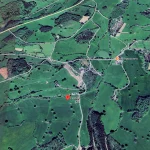UPDATE Forget 300Mbps G.fast, ASSIA Prep 1 Terabit DSL Copper Line Broadband
California-based ASSIA, which supplies broadband management systems to ISPs, has today announce that “extreme high frequency sub-millimeter waves” could in the future be used to push broadband speeds of up to 1Tbps (Terabit per second) down a single 100 metre twisted-pair copper line.
First let’s do a quick primer. Hopefully by now you’re all familiar with Openreach’s Fibre-to-the-Cabinet (FTTC) broadband technology, which takes a fibre optic cable to your local street cabinet and then pushes VDSL2+ down the final run of twisted-pair copper line to your home.
VDSL2 works with up to 17.664MHz of spectrum and offers top speeds of up to 80Mbps. The best speeds are usually achieved within 400-500 metres or so of your local street cabinet, although we’ve seen it working over distances of 2km; signal degradation / interference mean that performance at around 2km is much slower (c.10-15Mbps).
Advertisement
Likewise Openreach’s (BT) new 330Mbps G.fast technology adopts a roughly similar approach, albeit with various differences under the hood and 106MHz of spectrum (future updates could use double this and deliver around 500Mbps). The limits of this approach put a strain on coverage and so you have to live within 350 metres to get the best speeds (over 500 metres away and the performance takes a rapid dive).
Beyond G.fast there’s also the future prospect of XG.Fast that gobbles up to a hefty 500MHz of spectrum and might one day deliver a peak aggregate speed of c.8000Mbps (here) over 30 metres of twisted-pair copper (an early BT test achieved 5.6Gbps at a similar distance). However such short distances make delivering mass market coverage quite tricky and more expensive.
Anyway forget all of that because ASSIA’s Chairman and CEO, Dr. John Cioffi (Stanford Professor), appears to have entered what many might consider to be sci-fi territory by unveiling a future technology that could be capable of delivering 1Tbps (1,000,000Mbps or 1000Gbps) over a 100 metre run of normal copper telephone wire. Speeds would then decrease to 100Gbps at over 300m and 10Gbps at over 500m!
Dr. John Cioffi, Chairman and CEO of ASSIA, said:
“Fiber-like speeds of 10 – 1000’s of gigabits/second (Gbps) are possible by using the previously unexploited waveguide modes of current copper infrastructure. Waveguide-mode use is similar to use of millimeter-wave transmissions in advanced wireless and 5G. Waveguides can enable use of frequencies above 100 GHz for extraordinary speeds.
The challenge was to develop practical ways to use higher frequencies over wires. Working with my ASSIA colleagues Dr. Chan Soo Hwang, Dr. Ken Kerpez, and Dr. Ioannis Kanellakopoulos, we found a solution.”
The millimeter wave (mmW) area is where some of the highest frequency 5G trials like to play (e.g. 28GHz), while a few experimental wireless technologies have even toyed with 300GHz. However higher frequencies with wireless don’t travel very far and are painfully easy to disrupt, which requires a much denser (expensive) and more powerful network to overcome.
Advertisement
At first glance the idea of applying this to a normal copper line seems to defy a few fundamental laws of physics and we have significant doubts about how this might work in a real-world environment. On the other hand we never envisaged anything like G.fast when 56Kbps dialup modems were all the rage (rage as in “aaaarrrggggg slow!!!“) and yet it does exist today.
However ASSIA appears to be proposing a solution that sounds similar to one put forward by AT&T Labs last year, where existing power cables were used to “guide” a wireless broadband signal (here). This is different from a normal DSL style transmission and instead involves distributing a very high frequency wireless transmission by using the gaps between copper pairs.

The “gaps” in such copper cables tend to be very small and so you have to use tiny wavelengths and a fair bit of Vectoring to tackle interference, although we still have doubts about its use in a complicated real-world environment. Either way it’s not yet intended for domestic connectivity.
Advertisement
Cioffi added:
“I don’t expect anyone to need terabit/s (Tbps) to their home anytime soon. Terabits/s will be most valuable to the data centers controlled by phone companies as well as to internet companies such as Google and Microsoft. While Tbps demand may be a few years into the future, 10-100 Gbps speeds are important to networks today and will be a big market.
Rapid advances in the Internet of Things (IoT), including autonomous vehicles, means the number of connected devices requiring high-speed ubiquitous connectivity will increase dramatically in the next decade. We believe that Terabit DSL will play a critical role in serving the needs of that ecosystem with ultra-high-throughput and ultra-low-latency connectivity.”
Right, so it’s not for homes. Fair enough, although we suspect that a lot of the other use cases for Terabit DSL might be gobbled up by fibre optic cables before it actually arrives. In any case this is a fascinating announcement and more details should be revealed during tomorrow’s Paris G.fast Summit.
We should point out that John Cioffi is an American electrical engineer and one of the key people responsible for inventing Digital Subscriber Line (DSL / ADSL / VDSL etc.) technology in the first place (there was a time when many people thought DSL to be impossible too), which helped to revolutionise Internet access. If anybody can do this, it’s him.
UPDATE 10th May 2017
The related presentation slides have just been published ahead of today’s event (here), which reveals a lot more about the workings and model for TDSL technology.
Mark is a professional technology writer, IT consultant and computer engineer from Dorset (England), he also founded ISPreview in 1999 and enjoys analysing the latest telecoms and broadband developments. Find me on X (Twitter), Mastodon, Facebook, BlueSky, Threads.net and Linkedin.
« ITSPA Reveals the 2017 Best UK Internet VoIP Provider Award Winners

















































Comments are closed